Introduction
How to organize a minimalist pantry is a question more people are asking as busy lifestyles and endless choices leave our kitchens crowded and our minds cluttered. The minimalist pantry is a modern answer—offering not just a cleaner space, but a more peaceful, intentional way to cook and live. When you walk into your kitchen and see only what you truly need and love, you feel lighter and more in control of your day.
This article will guide you step by step through building a minimalist pantry that works for your real life, whether you’re cooking for one or feeding a busy family. With simple habits and mindful choices, anyone can enjoy a pantry that’s neat, functional, and free from overwhelm. Get ready to discover the freedom and clarity that come from embracing less—right in the heart of your home.
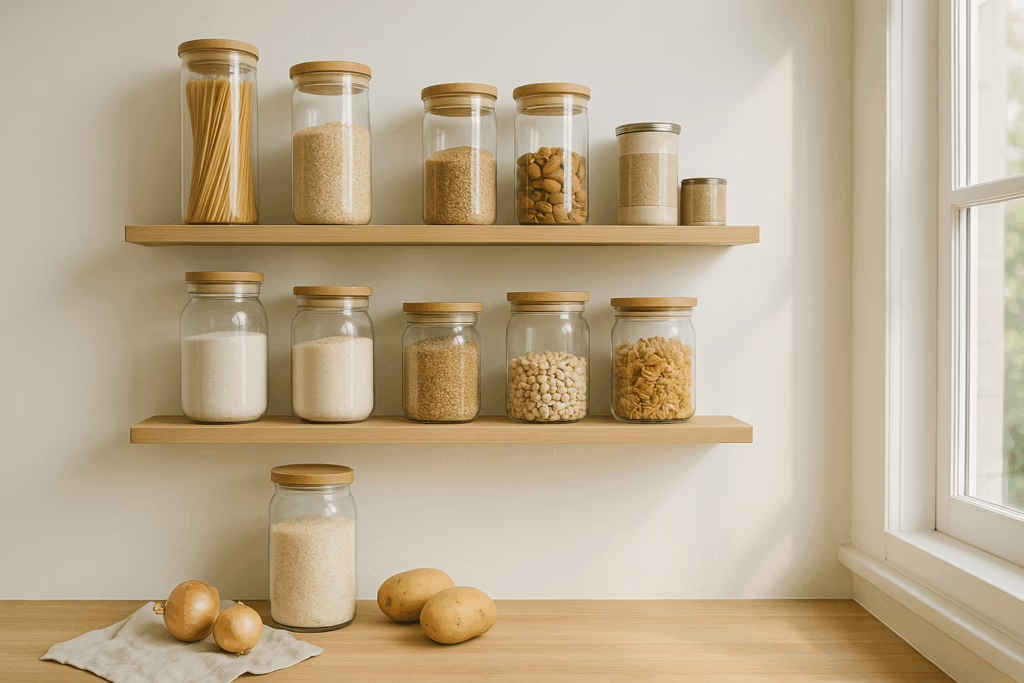
Understanding Minimalism in the Kitchen
A minimalist pantry is more than just a tidy cupboard with fewer items—it’s a reflection of intentional living. When you organize a minimalist pantry, you’re not simply reducing clutter; you’re setting up your kitchen for clarity, ease, and daily satisfaction. At its core, a minimalist pantry follows the principles of intentionality, simplicity, and functionality. This means every item earns its place because it serves a real purpose in your home. It isn’t about deprivation or making do with less than you need. Instead, it’s about choosing what actually supports your cooking and lifestyle, and letting go of the rest.
For many people, the journey toward a minimalist pantry begins with a desire for less stress and more joy in everyday routines. Imagine opening your pantry and knowing exactly where everything is, with only the foods you genuinely use and love. That’s the benefit of applying minimalist principles to your kitchen. It’s a mindset shift: rather than chasing after every new gadget or “must-have” ingredient, you find freedom in what you already own. And the difference between basic decluttering and true minimalism is intention. Decluttering might mean tossing out expired cans or half-used jars, but minimalism asks you to think deeper—what do you actually need to feel nourished and at ease?
Plenty of real-life examples show how transformative this approach can be. For instance, check out stories from The Minimalists about how letting go of excess food and kitchen tools led to calmer, happier meal times. Minimalism in the kitchen means your space works for you—not the other way around. It’s about finding contentment with enough, so your pantry serves as a foundation for stress-free, creative cooking.
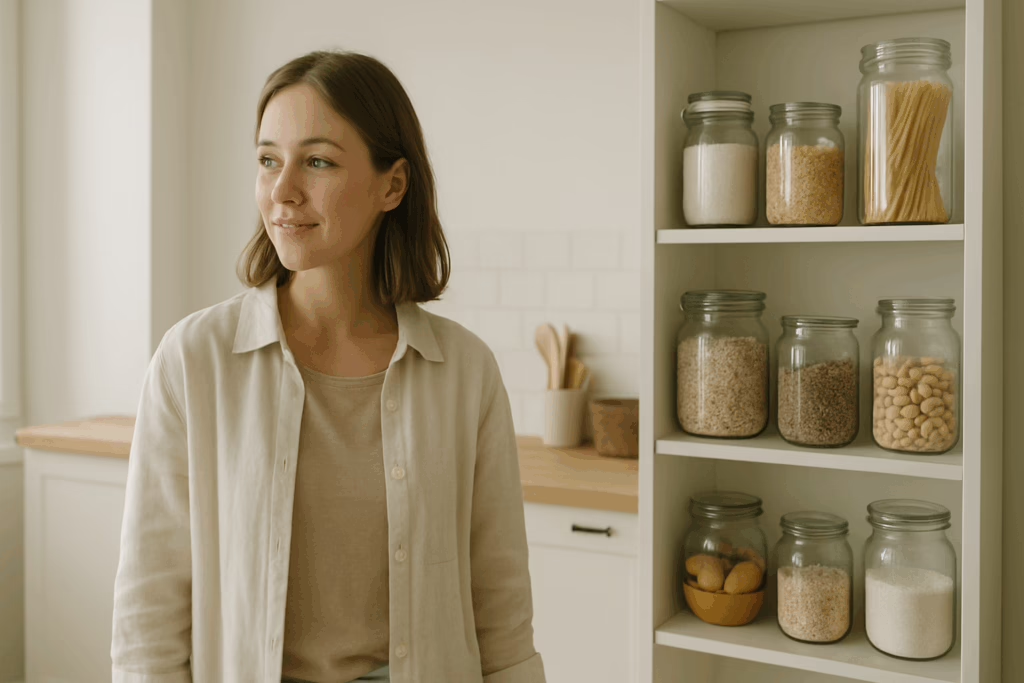
Assessing Your Current Pantry
To organize a minimalist pantry, the real work begins with a straightforward assessment of what you already have. Start by opening every door and shelf, and take an honest look at what’s inside. It’s easy to lose track of pantry items when things get pushed to the back or forgotten behind new purchases. Begin by removing everything, laying it out where you can see it, and sorting through each item one by one. Look for expired foods, duplicates you didn’t realize you had, and things you never use or don’t even like. This hands-on audit helps you see just how much has accumulated over time and reveals old habits that may not align with your minimalist goals.
Sometimes, letting go of pantry items feels like admitting a mistake or wasting money. But holding onto food you’ll never eat doesn’t serve anyone. Instead, consider this step an act of self-care—making room for only what you genuinely want and need. Donate unexpired, unopened food to a local food bank or shelter if possible. The process can feel emotional, but clearing out your space brings real relief and mental clarity. The difference between a cluttered shelf and a minimalist pantry isn’t just what’s gone, but how you feel about what remains. For more step-by-step tips, Becoming Minimalist’s pantry declutter guide is a practical place to start.
A real-world example: One reader shared that after a full pantry audit, she discovered three open jars of peanut butter, five half-empty bags of rice, and spices she didn’t remember buying. Once she cleared the duplicates and unused items, her pantry felt lighter, easier to use, and more aligned with her cooking habits. That’s the real reward of a minimalist pantry—a space that works for you.
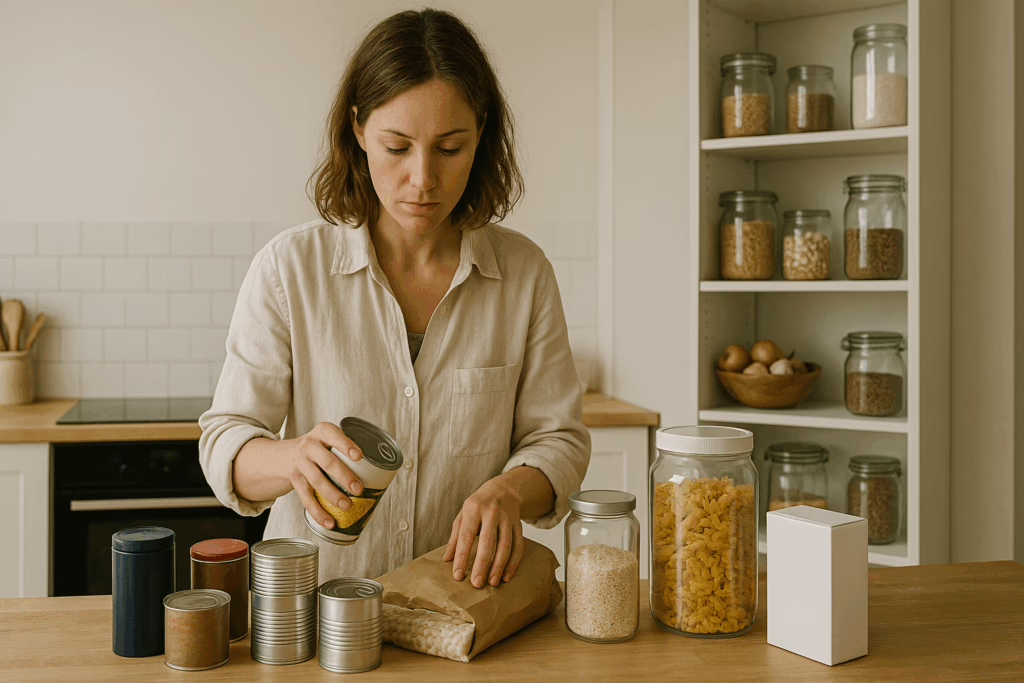
Defining Your Essentials
A minimalist pantry is built around what you truly need and use—your essentials. Defining these essentials isn’t about following a strict rulebook; it’s about choosing foods that match your actual cooking habits, health goals, and family size. Some pantries overflow with ingredients bought for one-time recipes or food trends, but a minimalist pantry is tailored to your reality. Begin by considering your weekly meals: What do you cook most often? Which staples do you run out of? For some, essentials include rice, pasta, beans, and a handful of go-to spices. For others, it may be nut butters, oats, and canned tomatoes. There’s no universal list, only what fits your household best.
It’s easy to get swept up by lists of “must-have” pantry items online, but the best minimalist pantry is personal. The essentials for a family of four will look different from those of a single cook. And just because a food is marketed as healthy or essential doesn’t mean it deserves space on your shelf. Take inspiration from sources like The Kitchn’s pantry essentials, but don’t be afraid to adapt it. The goal is to create a selection of foods you enjoy, use frequently, and can store with ease.
One family shared that after making a simple list of their essentials and sticking to it, their grocery bills dropped by a third, and they stopped wasting food. They discovered that most of their meals used the same core ingredients. By focusing on their essentials, their minimalist pantry became a tool for less stress and more joyful cooking.
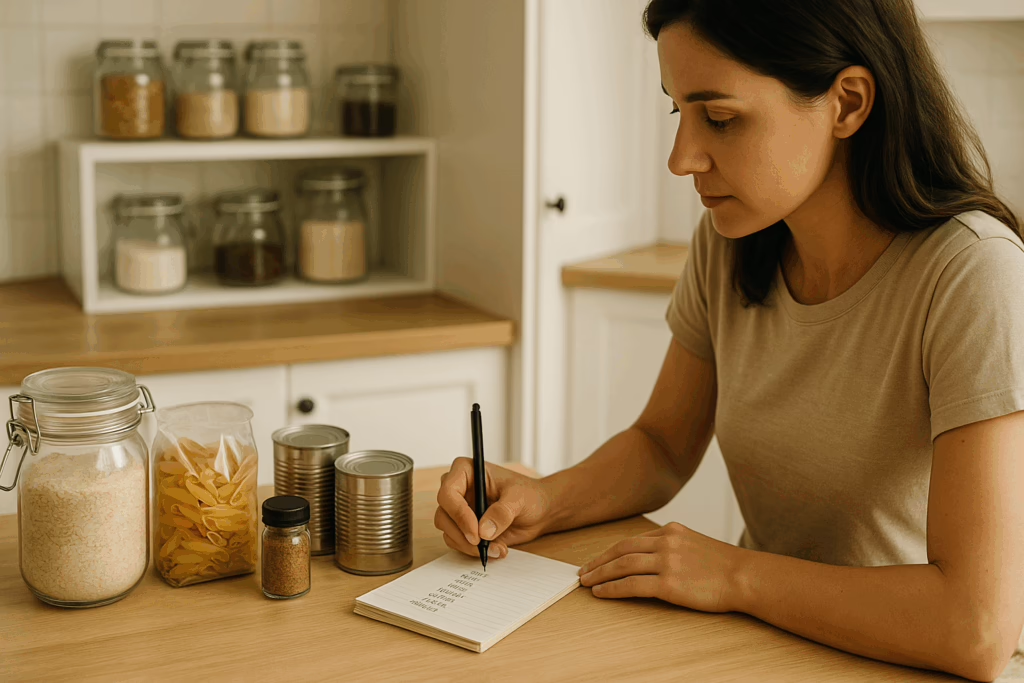
Creating a System that Works for You
The heart of a minimalist pantry is not just what you keep, but how you organize it to fit your real life. Organizing a minimalist pantry means creating a system that makes sense for your routines, kitchen space, and family needs. Some people thrive with clearly defined zones for baking, snacks, or breakfast, while others prefer to keep things more flexible. The goal is to reduce decision fatigue—when everything has a place, you spend less time searching and more time enjoying your meals.
Begin by grouping similar items together on shelves: grains with grains, cans with cans, spices in one spot. If you use containers, opt for clear, stackable jars that fit your shelves and make it easy to see what you have. But don’t get caught up in Instagram-perfect organization. A minimalist pantry doesn’t require matching bins or fancy labels—just a clear, consistent system you’ll actually use. The best solutions are practical, not decorative.
Adjust the setup as your habits change. If you notice certain foods are hard to reach, rearrange them so everyday staples are front and center. Label only where needed, such as for bulk foods or similar-looking items. Most importantly, keep your system flexible so it can evolve with your lifestyle. For practical ideas and inspiration, check out Good Housekeeping’s pantry organization tips.
Whether you’re working with an apartment kitchen, a family home, or a tiny pantry, what matters is how your minimalist pantry supports daily life. When your system works for you, even small kitchens can feel efficient and inviting.
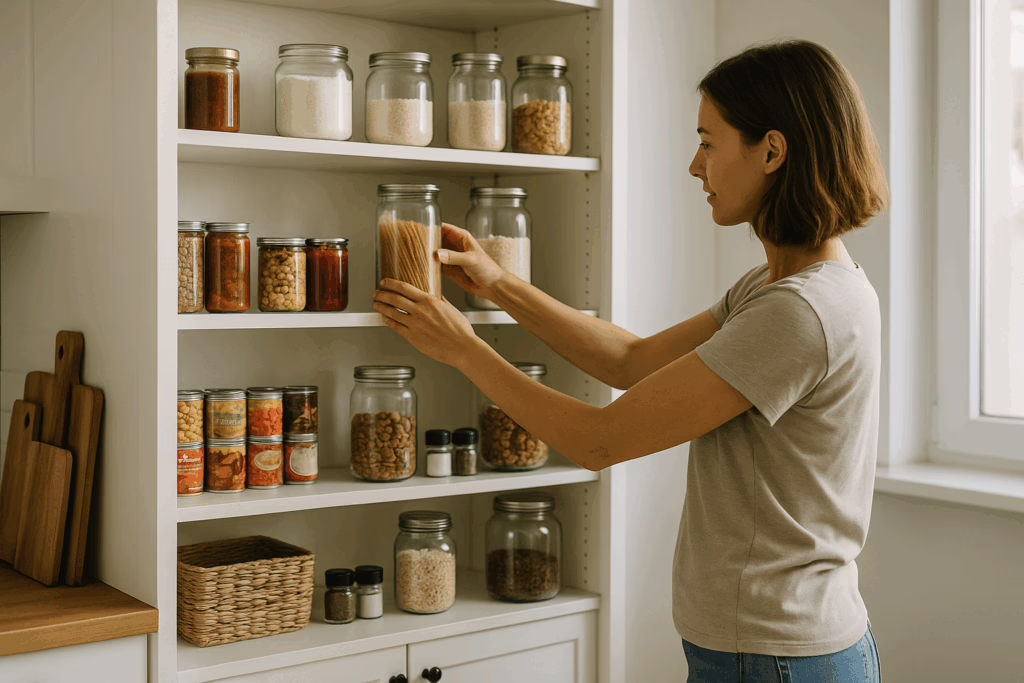
Smart Storage Solutions for Minimalist Pantries
A minimalist pantry shines when you make the most of your storage space with simple, functional solutions. Every pantry is unique, but a few strategies make almost any space feel bigger and more efficient. Vertical storage is a game changer—stackable bins and tall shelves use every inch from top to bottom. If your shelves are deep, use baskets or pull-out bins to prevent food from getting lost in the back. Slim racks on the inside of pantry doors are perfect for spices or snacks, keeping everyday items easy to reach and in view.
Choosing the right storage isn’t about buying the latest gadgets. Focus on basic containers that actually fit your shelves and daily habits. Clear jars and bins make it easy to spot what’s inside, so you can avoid overbuying or letting food go to waste. Avoid cluttering the pantry with containers for every category—sometimes the packaging food comes in is all you need. Make sure heavy items go on lower shelves for safety, and lighter items higher up.
If you have an awkward or tiny pantry, don’t worry. Creative solutions—like tiered organizers for cans or hanging baskets for produce—make even small spaces feel more useful. See how others are doing it at Apartment Therapy’s small pantry ideas. One reader turned a shallow linen closet into a minimalist pantry by adding a few sturdy shelves and hooks, proving that it’s about thoughtful design, not square footage.
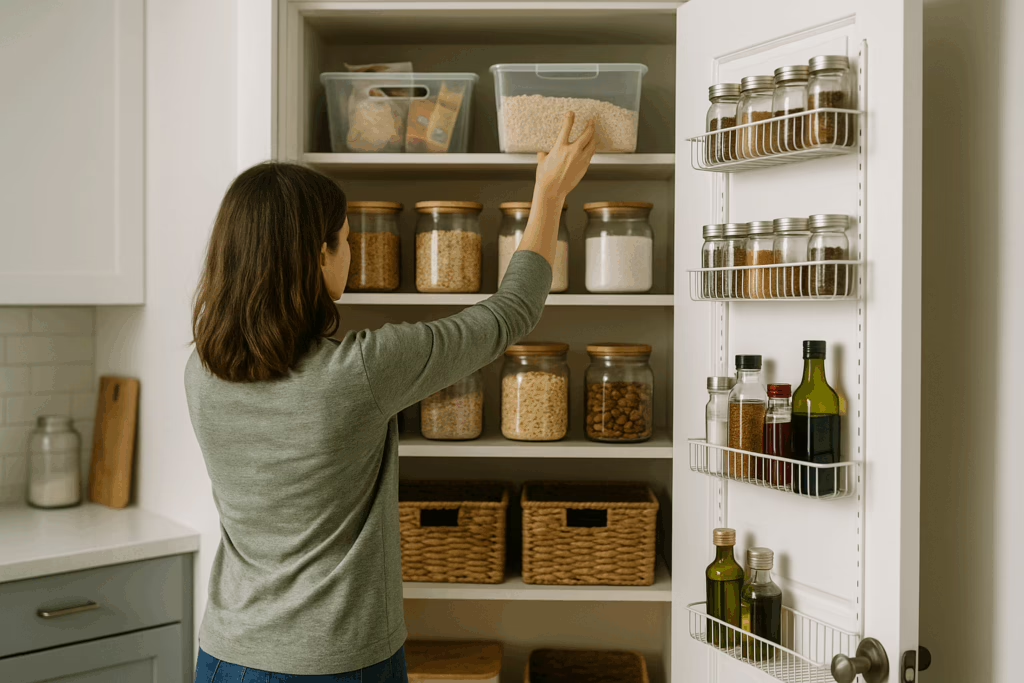
Restocking with Intention
A minimalist pantry stays clutter-free because it’s restocked with care, not impulse. Shopping for a minimalist pantry means buying only what you know you’ll use, in the quantities that fit your lifestyle and storage space. This approach saves money and prevents food waste. Before each shopping trip, check what you already have and plan meals around those ingredients. Making a specific list keeps you focused and limits those “just in case” purchases that crowd your shelves.
How often you shop depends on your schedule and preferences. Some people do a weekly restock with smaller trips for fresh goods; others buy in bulk every month, topping up pantry staples as needed. There’s no right answer—what matters is choosing a rhythm that keeps your minimalist pantry organized and your food fresh. If you’re buying in bulk, divide items into smaller containers so you can see what’s left at a glance.
Meal planning is one of the simplest ways to restock intentionally. It helps you stick to essentials, prevents buying duplicates, and ensures you always have what you need. If you need more tips, Love Food Hate Waste’s meal planning guide is full of practical advice.
A minimalist pantry isn’t about rigid rules—it’s about mindful choices. Every new addition should have a purpose and a place. The reward is a kitchen that feels lighter, easier, and always ready for your next meal.
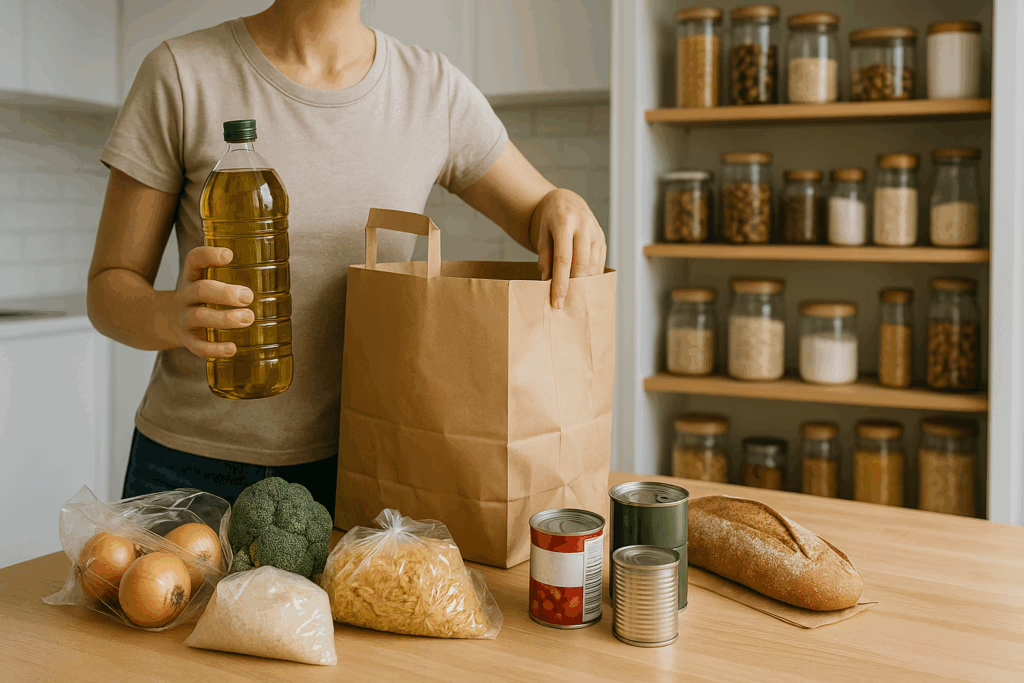
Maintaining Your Minimalist Pantry
A minimalist pantry stays simple not just because of how it’s set up, but because you maintain it regularly. The most important habit is a quick weekly check: spend a few minutes tidying shelves, putting away strays, and noting what’s running low. This habit keeps your minimalist pantry from drifting back into clutter or chaos. Every month or two, do a slightly deeper audit—check for expired items, forgotten ingredients, and anything that’s crept in that doesn’t fit your essentials.
Sticking with the minimalist mindset means you’re always open to change. If your cooking routines shift, or your family grows, update what you keep on hand. Maybe you try a new cuisine and discover a few more staples worth adding, or perhaps you realize you no longer need as much of a certain ingredient. The goal is not a perfect pantry, but one that always fits your needs. For ongoing guidance and inspiration, Minimalist Baker’s pantry maintenance page offers a flexible approach.
Families and singles alike can keep this process simple. A five-minute tidy-up before you shop, plus a monthly mini-purge, are usually enough. When your minimalist pantry works for you, keeping it organized becomes second nature, and your kitchen feels lighter day after day.
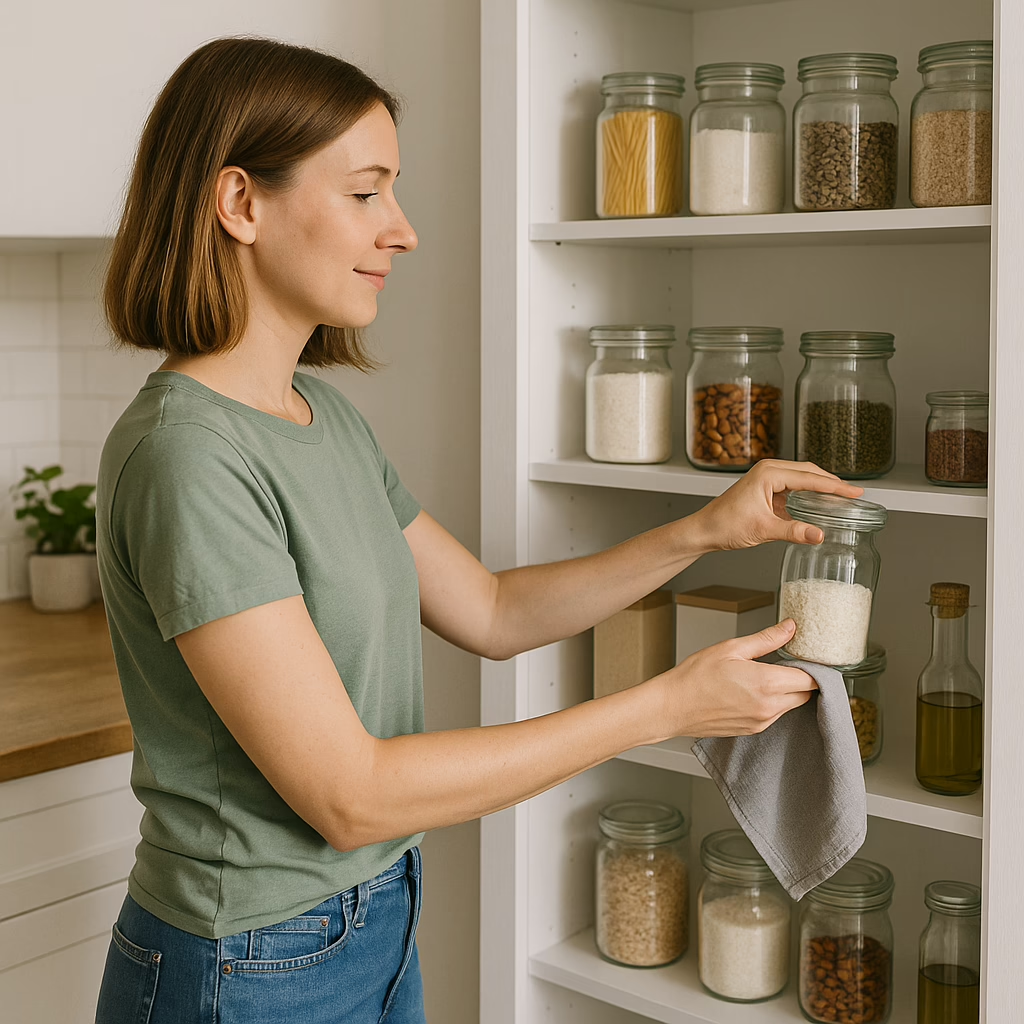
Conclusion
A minimalist pantry is a powerful foundation for a calmer, more intentional home. As you’ve seen, organizing a minimalist pantry isn’t about having empty shelves or following a strict rulebook. It’s about making thoughtful choices—clearing out what no longer serves you and building a pantry that truly supports the way you live and cook. With each step, from assessing your current pantry to defining essentials and maintaining your system, you’re setting yourself up for lasting peace and simplicity in the kitchen.
The rewards go far beyond clean shelves. You’ll save time, reduce stress, and enjoy a deeper connection to your daily meals. Whether you live alone or manage a busy family kitchen, a minimalist pantry can be shaped to fit your unique needs. Start small, be patient with the process, and remember that perfection isn’t the goal—progress is. If you’re inspired to transform your space, consider sharing your before-and-after photos or favorite tips with the community on social media. For more minimalist living ideas, don’t forget to subscribe and explore related articles.

